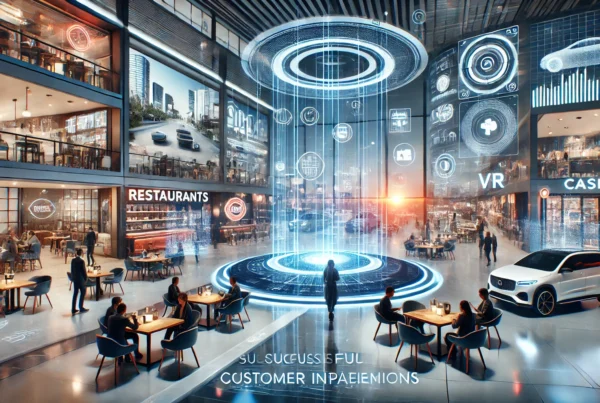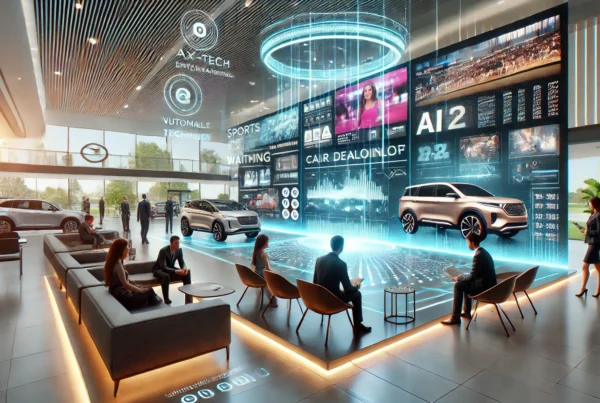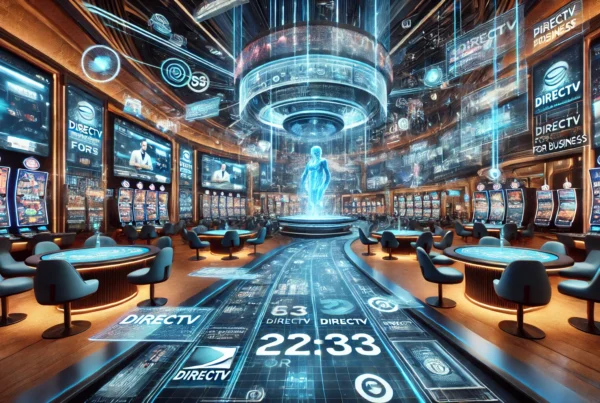In the rapidly evolving world of digital content, staying ahead of the curve is essential for businesses looking to captivate their audiences. As we approach 2025, the landscape of video programming is set to undergo a transformative shift, driven by technological advancements and changing consumer preferences. This shift presents both challenges and opportunities for business owners and decision-makers in industries like hospitality, gaming, automotive, and private offices. To navigate this dynamic environment, embracing Innovative Video Programming Strategies for 2025 becomes crucial.
Imagine a world where your video content not only entertains but also engages and converts viewers into loyal customers. With the right strategies, you can harness the power of video to enhance customer experiences, drive business growth, and maintain a competitive edge. According to a recent report, video content is expected to account for over 82% of all internet traffic by 2025, underscoring its significance in any digital strategy.
At Sports Direct, we understand the unique challenges faced by businesses in delivering impactful video content. Our mission is to provide cutting-edge solutions that not only meet but exceed the expectations of your audience. From leveraging AI-driven personalization to exploring the potential of augmented reality, our comprehensive guide will delve into innovative strategies that can revolutionize your approach to video programming.
Join us as we explore these strategies in detail, offering insights and actionable tips to help you implement them effectively. Whether you’re looking to enhance on-premise entertainment in a bustling restaurant or create an immersive experience in a private office, our guide will equip you with the knowledge and tools needed to succeed in 2025 and beyond.
Personalized Video Experiences: Tailoring Content for 2025
As we approach 2025, the demand for personalized video experiences is skyrocketing. Businesses are increasingly leveraging AI and data analytics to tailor content that resonates with individual viewers. This shift is not just a trend but a necessity for enhancing customer engagement and retention. Personalized video content allows businesses to connect with audiences on a deeper level, fostering loyalty and driving growth.
Personalization in video programming is transforming how companies interact with their audiences. By analyzing user data, businesses can deliver content that aligns with viewer preferences and behaviors. This approach not only enhances the viewing experience but also increases the likelihood of converting viewers into customers. Let’s explore how AI-driven personalization and user data analysis are revolutionizing the video programming landscape.
AI-Driven Personalization Tools
AI tools are at the forefront of this personalization revolution. Platforms like Netflix and YouTube have set the standard by using AI algorithms to recommend content based on user behavior. These tools analyze viewing history, preferences, and engagement patterns to suggest videos that viewers are most likely to enjoy.
For businesses, adopting similar AI-driven personalization strategies can significantly enhance customer satisfaction. Tools such as IBM Watson and Adobe Sensei offer powerful AI capabilities that enable content creators to customize video elements like text, visuals, and calls to action. By integrating these tools, companies can ensure that each viewer receives a unique and engaging experience.
Successful Personalization Strategies
Several companies have successfully implemented personalization strategies to boost engagement. For instance, Spotify’s “Wrapped” campaign personalizes the user experience by providing listeners with a summary of their most-played songs and artists. This personalized content not only delights users but also encourages them to share their experiences, increasing brand visibility.
Another example is Amazon Prime Video, which uses personalized recommendations to keep viewers engaged. By analyzing user data, Amazon suggests shows and movies tailored to individual tastes, enhancing the overall viewing experience and encouraging longer watch times.
Challenges and Solutions in Personalization
Despite its benefits, personalization in video programming comes with challenges. One major concern is data privacy. As businesses collect more user data to personalize content, they must ensure that they comply with privacy regulations and protect user information.
To address these challenges, companies should implement robust data protection measures and be transparent about how they use customer data. Additionally, leveraging anonymized data can help mitigate privacy concerns while still allowing for effective personalization.
Another challenge is the complexity of implementing AI-driven personalization. Businesses may face difficulties in integrating AI tools with existing systems. To overcome this, companies can partner with technology providers that offer seamless integration solutions and provide training to help teams effectively use these tools.
Emerging Technologies in Video Programming
As we approach 2025, the landscape of video programming is being revolutionized by emerging technologies such as augmented reality (AR), virtual reality (VR), and 360-degree videos. These technologies are not just enhancing how content is consumed but are fundamentally reshaping the strategies businesses use to engage their audiences. By integrating these innovations, companies can create more immersive and interactive experiences that captivate viewers and foster deeper connections.
Incorporating AR, VR, and 360-degree videos into video programming strategies offers a unique opportunity for businesses to stand out in a crowded digital landscape. These technologies allow for the creation of content that is not only visually stunning but also highly engaging, providing viewers with an experience that is both memorable and impactful. Let’s delve into how these technologies are shaping the future of video programming and explore their potential applications across various industries.
Augmented Reality (AR): Enhancing Real-World Interactions
Augmented reality (AR) overlays digital content onto the real world, offering a blend of physical and virtual experiences. This technology is gaining traction in industries such as retail and automotive, where it enhances customer interaction. For instance, car dealerships can use AR to allow potential buyers to visualize different vehicle models and configurations in real-time, providing a personalized shopping experience. According to a report by Deloitte, AR has the potential to significantly boost customer engagement and sales by offering interactive and informative content.
Moreover, AR is being utilized in the hospitality industry to enhance on-premise entertainment. Restaurants and bars can offer interactive menus or immersive storytelling experiences, creating a unique atmosphere that encourages customer retention. By integrating AR into their video programming strategies, businesses can offer innovative solutions that not only attract but also retain customers.
Virtual Reality (VR): Creating Immersive Worlds
Virtual reality (VR) takes immersion to the next level by transporting users into entirely virtual environments. This technology is particularly effective in industries like gaming and real estate, where immersive experiences can significantly enhance user engagement. For example, casinos can use VR to offer virtual tours of their facilities or create immersive gaming experiences that attract tech-savvy customers.
In real estate, VR allows potential buyers to explore properties remotely, providing a comprehensive view of the space without the need for physical visits. This not only saves time but also broadens the reach of real estate agents, enabling them to showcase properties to a global audience. As VR technology continues to advance, its applications in video programming are expected to grow, offering more opportunities for businesses to engage with their audiences in innovative ways.
360-Degree Videos: Offering Panoramic Views
360-degree videos provide a panoramic view of a scene, allowing viewers to explore content from multiple angles. This technology is particularly popular in the travel and tourism industry, where it offers potential tourists a virtual glimpse of destinations. By providing an immersive experience, 360-degree videos can inspire viewers to visit the locations showcased, driving tourism and boosting local economies.
Additionally, 360-degree videos are being used in educational settings to offer virtual field trips and immersive learning experiences. This approach not only enhances student engagement but also provides access to educational content that might otherwise be inaccessible. As businesses continue to explore the potential of 360-degree videos, they are likely to discover new ways to engage and educate their audiences.
Strategies for Maximizing Video SEO in 2025
As video content continues to dominate the digital landscape, optimizing it for search engines becomes crucial. In 2025, video SEO strategies will evolve to meet the demands of advanced algorithms and changing viewer behaviors. By leveraging innovative techniques, businesses can enhance their video visibility, engage more viewers, and drive growth.
Understanding the importance of video SEO involves recognizing the role of metadata, keywords, and video sitemaps. These elements ensure that search engines can effectively index and rank your content. Let’s dive into the strategies that will maximize your video SEO efforts in 2025.
Optimizing Metadata and Keywords
Metadata plays a pivotal role in video SEO. It includes titles, descriptions, and tags, which help search engines understand the content of your videos. To optimize metadata, ensure your titles are concise yet descriptive, incorporating relevant keywords naturally. Descriptions should provide a summary of the video content, including primary and secondary keywords to enhance discoverability.
Using keyword research tools can help identify trending and relevant keywords specific to your industry. Incorporate these keywords strategically across your metadata and video content. Remember, the goal is to make your video easily discoverable while maintaining a natural flow of information.
Implementing Video Sitemaps
Video sitemaps are essential for improving the visibility of your video content. They provide search engines with detailed information about your videos, such as duration, category, and target audience. By submitting a video sitemap to search engines, you ensure that your content is indexed accurately and efficiently.
Creating a video sitemap involves listing all video URLs along with their metadata. This structured approach helps search engines understand the context of your videos, increasing the chances of them appearing in search results. Regularly updating your sitemap as you add new content is crucial for maintaining optimal visibility.
Leveraging Social Media and Backlinks
Social media platforms are powerful tools for boosting video SEO. Sharing your videos across platforms like YouTube, Instagram, and TikTok can increase engagement and drive traffic to your website. Each platform has unique optimization techniques, such as using hashtags on Instagram or keywords in YouTube descriptions, to enhance visibility.
Building backlinks is another effective strategy for improving video SEO. Encourage other websites to link to your video content, as this signals to search engines that your content is valuable and authoritative. Collaborating with influencers or industry experts can also help generate high-quality backlinks, further boosting your SEO efforts.
- SEO Checklist for 2025:
- Optimize metadata with relevant keywords.
- Create and regularly update video sitemaps.
- Share videos on social media platforms.
- Build backlinks through collaborations.
Embracing the Future of Video Programming
As we stand on the brink of 2025, it’s clear that Innovative Video Programming Strategies for 2025 are not just options but necessities for businesses aiming to thrive in a competitive landscape. The integration of personalization, emerging technologies, and SEO optimization forms the trifecta for success in this evolving digital era. By embracing these strategies, companies can create captivating content that not only entertains but also converts and retains customers, ensuring sustained growth and engagement.
Personalized video experiences have emerged as a fundamental strategy, allowing businesses to connect with their audiences on a deeper level. By leveraging AI-driven personalization tools, companies can tailor content to individual preferences, enhancing viewer satisfaction and loyalty. This approach not only transforms the viewing experience but also increases conversion rates, as seen with platforms like Netflix and Spotify that have set benchmarks in personalization.
Emerging technologies such as augmented reality (AR), virtual reality (VR), and 360-degree videos are reshaping the video programming landscape. These innovations offer businesses the opportunity to create immersive and interactive experiences that captivate viewers. By incorporating these technologies, companies can differentiate themselves in a crowded market, providing unique and memorable experiences that foster brand loyalty.
To maximize the impact of video content, optimizing for search engines is crucial. Video SEO strategies, including the use of metadata, keywords, and video sitemaps, ensure that content is easily discoverable. By implementing these techniques, businesses can enhance their video visibility and engage a wider audience. Additionally, leveraging social media platforms and building backlinks can further boost video SEO efforts.
- Key Takeaways:
- Embrace AI-driven personalization for deeper audience connections.
- Incorporate AR, VR, and 360-degree videos for immersive experiences.
- Optimize video content with SEO strategies to enhance discoverability.
As you embark on this journey of innovation, consider exploring more resources on Sports Direct’s website to further enhance your video programming strategies. Share your experiences and insights in the comments, and let’s build a community of forward-thinking businesses ready to succeed in 2025 and beyond.








